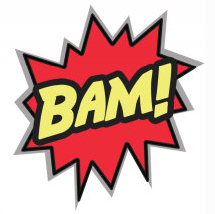Last week the Dallas Observer reported that Dallas County will print a series of graphic novels to teach kids in juvenile detention about rape. The Project on Addressing Prison Rape at American University, Washington College of Law is behind the comics, which are available in full on the project's site.
A warning: they're weird. Not just because you're reading material designed to educate kids about rape, but because of the way in which the choice of form--a comic strip--seems to inherently turn what is a very serious thing into a lighthearted romp. This isn't parody for the sake of stressing the weightiness of the issue; it's not about placing a horrific phenomenon in a playful genre in order to highlight its grimness via juxtaposition. This is exactly what it purports to be: a set of traditional comic books (or graphic novels--same thing) with sexual assault plots. The panels where rape happens read: BAM!
If that isn't already unsettling, here's the other thing. The series conveys problematic messages like: you should be concerned whether being raped by someone of the same sex makes you gay; you should expect your superiors not to believe you when you report an assault; and even, ironically, you should expect to be raped if you wind up in juvenile detention.
These leave me wondering--is the problem really education?
Certainly, educational efforts on prison rape should be applauded, and it is tempting to want to avoid critiquing anyone doing anything to address such an important issue. Remote, academic appraisals of others' bold, sincere efforts to improve the world tend to strike me as parasitic and unhelpful, not to mention potentially destructive in the most irritating way. If you don't like how Sam Feeds the World Oranges is feeding the world oranges because his oranges aren't organic, or he's only feeding some of the world, or because he has high overhead, then start your own Feed the Actual, Entire World Organic Oranges for Low Overhead. Don't write an article ripping apart Sam as you sip Pinot Grigio and nibble on a fresh goat cheese.
On the other hand, there are noble and commendable projects that nonetheless are fraught, and they can still be noble and commendable but need improvement. This is one of those projects.
First, the BAM! rape scenes:

If you don't want to include a graphic illustration of rape in a graphic novel about rape, that's understandable. But I'd be interested to hear victims of sexual assault weigh in on what they believe a graphic representation of rape might look like, and I suspect that it wouldn't be the jaunty exploding star that in 100% of the world's comic strips denotes exaggeration for the purpose of humor. I'd predict that rape, illustrated looks something more like this:

Or this:

Empty space. Psychological time warp. These, as opposed to a hyperbolic presentation of the literal sound a body makes pounding against a concrete floor.
In the project's featured story, Billy Speaks Out, Billy is raped by his cellmate and his first concern is whether this makes him gay. It's a strange line to read, because while on one hand it feels realistic--assault raises questions of sexual identity for many people (not just about orientation but questions like "am I still a virgin?"), on the other it has the tinge of discrimination, hinting that if in fact it did make Billy gay, that would be a bad thing. ("This don't make you gay," Billy's friend says to him reassuringly on the basketball court later.) Even apart from its muted sanction of homophobia, it's strikingly detached from the emotionally ragged experience of victimhood. Billy's very first reaction after being attacked is, "Does this make me gay?" Not: How can this be happening? What did I do? Why do I feel so guilty, like I've done something wrong? Why did God/my parents/the adults/the government let this happen to me? How do I survive? Why can't I even cry?
Fortunately, another of the stories, Carlos' Question, is all about how it's okay to be who you are, including if you're gay--so let's hope whoever reads Billy Speaks Out also reads that one.
But the most problematic aspect of Billy's story is that Billy reports the rape to his counselor, is callously dismissed, and has to try again later with a nicer officer. The lesson it's teaching seems to be that adults aren't going to be there to protect you, even when you seek out help, so just keep trying. This strikes me as a bit victim-blame-y; why are raped youth being taught they need to keep asking for help after they are brutalized then ignored when they report it? Why are they being told that when the official to whom they report the crime tells them, "Too bad, you asked for it," they should try again with another grown up? Eventually, you'll reach a grown up who cares! Just keep going through grown ups!
How about: fix policies that permit, whether explicitly or implicitly, adults to dismiss youths reporting sexual assault, then teach youth that they can trust adults. The onus should not be on the victimized powerless to adjust to inadequate protections supplied by those charged with protecting them, especially when those victims are children. Codifying the bad behavior of adults employed by the government to oversee the care of children, criminal or not, by incorporating that bad behavior into an instructional curriculum casts this eerie, troubling phenomenon in high relief. If I were a kid reading this, what I might very well take from it is: why bother telling? I'm just going to be ignored.
Furthermore, while the project is aimed at juveniles already being detained, the stories clearly reach a much wider audience. For youth who are not yet incarcerated, the normalization of prison rape by the series--it almost feels inevitable--could be quite alarming, even insofar as to affect pleas (if you think it's pretty definite you're going to get raped in juvy, you're going to do whatever it takes not to wind up there, even if that means pleading guilty to a crime you didn't commit so you get a lesser penalty).
For such a strange choice of medium--one wonders why not a video or some other (probably more appropriate and less awkward) form here in this late digital age--the comics do have notable strengths. There are empty panels at the end of every book (You Finish the Story) and discussion questions for facilitators. Both are good tools to maximize the project's educational value. And the stories targeting younger children (ages 10-13) on inappropriate touching lack the troubling aspects of the rape stories, which target ages 14-18. But in the next round, perhaps the campaign should more carefully consider what collateral messages are being delivered through the earnest accounts of these young, make-believe victims. Teenagers may prefer comics to dry, pictureless pamphlets, but they're smart. They can read between the panels.
